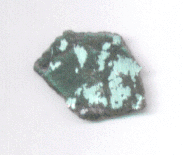Lowicz
MesosideriteOne of two main types of stony-iron meteorite, the other being pallasites. Mesosiderites are a mixture of approximately 50% basaltic, gabbroic and orthopyroxenitic silicates and 50% Ni-Fe metal and sulfides. The name derives from the Greek "mesos" meaning "middle" or "half" and "sideros" for "iron;" hence "half-iron". The silicates are Click on Term to Read More, group 3A
Fell March 12, 1935
52° 0′ N., 19° 55′ E. At 12:52 A.M. near Lowicz, Poland, a shower of stones was seen and heard to fallMeteorite seen to fall. Such meteorites are usually collected soon after falling and are not affected by terrestrial weathering (Weathering = 0). Beginning in 2014 (date needs confirmation), the NomComm adopted the use of the terms "probable fall" and "confirmed fall" to provide better insight into the meteorite's history. If Click on Term to Read More over an area of 9.2 km² along a trajectory from west to east. However, in contrast to most other fall distributions, the smallest fragments were recovered in the farthest part of the strewnfield near Seligow, while the larger pieces were found in the closest part in Krepa. This reversed distribution could be the result of fragmentation low in the atmosphere. At least 83 and perhaps over 100 stones with a total weight of over 60 kg were eventually recovered, but many were subsequently lost during World War II.







